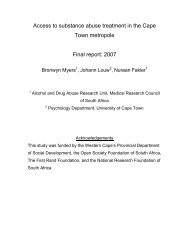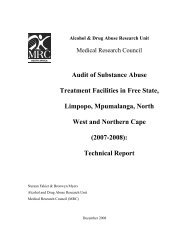Pan-African Conference 21 - 24 July 2002 Inter-Continental Hotel ...
Pan-African Conference 21 - 24 July 2002 Inter-Continental Hotel ...
Pan-African Conference 21 - 24 July 2002 Inter-Continental Hotel ...
Create successful ePaper yourself
Turn your PDF publications into a flip-book with our unique Google optimized e-Paper software.
Abstracts 10/22/02 11:26 AM Page 19<br />
ABSTRACT NO. 100. USE OF FOOD 2.0. SOFTWARE IN PERMANENT<br />
MONITORING OF NUTRITIVE VALUE OF FOOD RATIONS USED IN<br />
NUTRITION OF SOLDIERS FROM POLISH ARMY’S SPECIAL TROOPS<br />
BASED ON POLYUNSATURATED FATTY ACIDS CONTENT<br />
ESTIMATION<br />
Rozmysl E, Bertrandt J, Klos A<br />
Military Institute of Hygiene and Epidemiology, 4 Kozielska St., Warsaw, Poland<br />
Permanent monitoring of nutrition manner is particularly important for<br />
soldiers doing military service. Soldiers make a group of young men whose<br />
organism development is not finished completely and physical and psychical<br />
load are huge. Computer technology is most often used for nutrition<br />
monitoring. Results of performed researches on estimation of fats’ content and<br />
structure in daily food rations (DFR) planned for soldiers from special troops<br />
in Polish Army nutrition are presented in this work.<br />
Total of 69 DFR planned for nutrition in particular seasons (spring, summer,<br />
autumn, winter) were the base for the researches. Calculation software FOOD<br />
2.0. (1998) issued by Institute of Food and Feeding was used for calculations<br />
of fats’ content and structure. Researches results allow concluding that total<br />
fats level in analyzed DFR is in accordance to nutrition norms. Fats delivered<br />
in an average 28,0% of entire energy, differentiating seasonally from 25,2% in<br />
spring to 31,2 % in autumn. Contribution of energy from saturated fatty acids<br />
slightly exceeded recommended norms and amounted in an average 10,6%<br />
(from 9,9% in spring to 11,4% in autumn). Level of energy coming from<br />
polyunsaturated fatty acids in DFR, amounting in an average 4,5%, in every<br />
examined season met the required minimum, i.e. 3% (from 3,9% in spring to<br />
5,0% in summer). The EPA and DHA fatty aids together delivered in an<br />
average 0,10% of total food ration’s energy, seasonally. During summer and<br />
winter these values were as follows: 0,05% and 0,06%, and did not meet the<br />
required minimum i.e. 0,07% food ration’s energy.<br />
Ratio of n-6 and n-3 fatty acids was close to recommended values and<br />
amounted from 5,9:1 in autumn to 7,7:1 in summer.<br />
ABSTRACT NO. 101. ESTIMATION OF MINERAL ELEMENTS<br />
CONTENT IN MEALS PLANNED FOR CHILDREN GOING TO<br />
MILITARY KINDERGARTENS IN WARSAW BASED ON ELECTRONIC<br />
DATA BASE<br />
Bertrandt J, Klos A, Rozmysl E<br />
Military Institute of Hygiene and Epidemiology, 4 Kozielska St., Warsaw, Poland<br />
The aim of the work was utilization of computer calculation software to<br />
estimate content of selected mineral elements in meals planned for children in<br />
kindergartens. To estimate content of sodium, potassium, calcium,<br />
phosphorus, magnesium, iron, zinc, copper and manganese the calculation<br />
software FOOD 2, which is based on "Food Composition Tables" and<br />
"Statistica" program for statistic estimation of obtained results were used.<br />
Obtained results were compared to obligatory in Poland norm for children<br />
aged 3-6. It was found that average sodium content planned in daily food<br />
rations was 1365,5±374 mg, potassium <strong>24</strong>81,1±351 mg, calcium 504,9±111,1<br />
mg, phosphorus 810,2±108 mg, magnesium 184,0±mg, iron 7,8±2,1 mg, zinc<br />
6,8±1,5 mg, copper 0,83±0,13 mg and manganese 2,18±0,7 mg. From among<br />
analyzed mineral elements calcium content met the requirements in 84,1%,<br />
and zinc in 90,7%. Exceeded sodium and potassium content was found in<br />
planned rations compared to the norm. Content of other elements met the<br />
requirements for children alimentation.<br />
ABSTRACT NO. 102. Learning about micronutrient nutrition: A CD-ROM<br />
series for self-directed learning<br />
Chang M1 , Simpson J Randall1, Boy E2 , Bégin F2 , Cervinskas J2 , S Atkinson1 1 Department of Pediatrics, McMaster University, Hamilton, Ontario, L8N 3Z5<br />
Canada<br />
2 The Micronutrient Initiative, Ottawa, Ontario, K1G 3H9 Canada.<br />
Micronutrient deficiencies affect millions worldwide, including many living in<br />
Africa. The devastating health and economic outcomes are preventable<br />
through a variety of coordinated intervention strategies, including education<br />
of future health professionals in affected countries. As an effort to strengthen<br />
education as a means of eliminating micronutrient malnutrition, the<br />
Micronutrient Initiative collaborated with McMaster University to produce a<br />
three-part series of CD-ROMs for use in training health professionals at the<br />
undergraduate level in developing countries. Each CD-ROM addresses one of<br />
ABSTRACTS<br />
the three most prevalent micronutrient deficiencies worldwide: Iodine<br />
Deficiency Disorders, Vitamin A Deficiency, and Iron Deficiency.<br />
The contents of the CD-ROMs are developed based on current scientific<br />
literature, technical reports from the World Health Organization and other<br />
agencies, input from experts in micronutrient nutrition, and from students at<br />
international partner institutions. Each CD-ROM introduces the user to the<br />
biology, clinical aspects, community-based control strategies of a<br />
micronutrient deficiency, and a case scenario facilitates learning in problembased<br />
format. Text in concise point form, diagrams, graphs, and photographs<br />
are incorporated. Users can click the hypertext to view definitions for key<br />
terms and detailed information in pop-up windows, a quiz at the end of each<br />
section that scores at the click of a button allows for self-evaluation of<br />
knowledge. A users’ guide accompanies each CD-ROM and provides<br />
suggestions on how to use this tool to supplement existing curricula and for<br />
self-directed learning. This CD-ROM series is available to individuals and<br />
institutions in developing countries free of charge. (Funded by The<br />
Micronutrient Initiative.)<br />
ABSTRACT NO. 104. EVOLUTION OF THE SOUTH AFRICAN FOOD<br />
COMPOSITION DATABASE MANAGEMENT SYSTEM<br />
Sayed N 1 , Humphreys J 2<br />
1 Dietetics and Human Nutrition, University of Natal<br />
2 Nutrition <strong>Inter</strong>vention Unit, Medical Research Council<br />
A handwritten chart, drafted by dietitians at the Medical Research Council<br />
(MRC) in the 1970s to meet in-house research needs, heralded the first South<br />
<strong>African</strong> Food Composition Database. In the 1980s, as the demand for food<br />
composition data (FCD) and a printed food composition table (FCT) grew, the<br />
expanded FCD (borrowed largely from the USDA database) was<br />
computerised using the SAS system. This recorded a food code, food name,<br />
food group, a main reference for the data, the nutrient name, and nutrient<br />
value. In the mid-1990s, mandated with the task to update the database with<br />
the new South Africa data on fruit and vegetables, the dietitians at the MRC<br />
begun working on a new system to comprehensively document FCD<br />
compilation information. This development process was enhanced with the<br />
advent of South Africa into the international research scene, enabling sharing<br />
of expertise and learning from other compilers’ experiences. Working with an<br />
in-house computer programmer at the MRC, a relational database<br />
management system was set up using Microsoft Access. Visual Basic<br />
programming was used to customize the database functionalities. In<br />
consultation with INFOODS, a food description system and new<br />
ECSAFOODS food grouping system was adopted. Other features of the<br />
system include: a reference and source type for each nutrient, a record of all<br />
calculations done, integrity tests to check data compilation, a recipe<br />
calculation feature, data export facility, and standardized report formats to<br />
assist in the preparation of FCTs. In 2000, a user manual for SAFOODS (South<br />
<strong>African</strong> Food Composition Database Management System) was drafted.<br />
Further developmental plans include incorporation of TAGNAMES.<br />
SAFOODS has the potential to assist with food data compilation and facilitate<br />
data interchange in the ECSAFOODS region.<br />
ABSTRACT NO. 108. IS AUDIO COMPUTER-ASSISTED SELF-<br />
INTERVIEWING (ACASI) A FEASIBLE METHOD FOR COLLECTING<br />
SENSITIVE INFORMATION?<br />
Waruru Anthony, Tylleskär Thorkild<br />
Centre for <strong>Inter</strong>national Health, Armauer Hansen Building, N-50<strong>21</strong> Bergen, Norway,<br />
The latest advances in decreasing mother-to-child transmission of HIV by<br />
dosing anti-retroviral drugs at delivery has led to a situation where an<br />
increasing number of mothers are aware of their HIV-positive status and at the<br />
same time they know their child is likely not to be infected. Since the HIV can<br />
be transmitted in the postnatal period through breastfeeding, the ethical<br />
dilemma of whether these mothers should breast-feed or not is now<br />
challenging the scientific community. There is a need to collect reliable<br />
information on infant feeding practices in resource poor settings within the<br />
context of HIV. Face to face interviewing has obvious limitations due to the<br />
sensitive nature of the questions. In addition, the information may be flawed<br />
due to socially desirable responses. Such questions call for less intrusive<br />
methods of interviewing. We are going to explore the use of Audio-Computer<br />
Assisted Self-administered <strong>Inter</strong>viewing (ACASI) and compare it with face-toface<br />
interviewing.<br />
S19

















